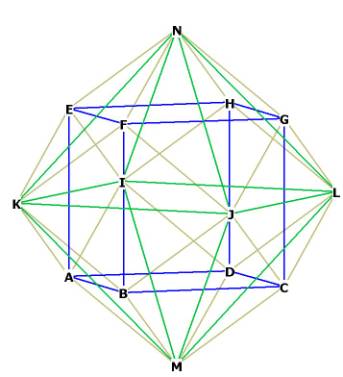|
(2017
midterm assignment) Model Student Midterm answers 2016 (Index) Essay 1: Compare, contrast, and evaluate Narratives of the Future |
 |
Kerisha Loctor
October 11, 2017
Three Perspectives: Narratives for the Future
There are many ideas of what the future holds that circulate around the
globe. Though they may differ based on culture and geography, they tend to
revolve around three main perspectives: creation/apocalypse, evolution, and
alternative. The creation/apocalypse model consists of linear story-telling
starting from the creation or revelation of truth and ends with chaos and
destruction, but with a promise of a new beginning. The evolution model consists
of a spiral form of storytelling that tells of possible progress and change from
one point to the next. Contrary to what Marion Johnson outlined in her essay,
that these models typically do not work well together but are usually used
separately, these models actually do work well simultaneously.
The creation/apocalypse model of narratives for the future is primarily
seen in books of religion or mythology, such as the Bible. The timeline is
linear in which the “creation” stage of the Bible starts in Genesis, where the
creation of Earth and man takes place. The creation of man takes place in
Genesis 1:27, “So God created man in his own image, in the image of God created
he him…” The “apocalypse” stage is mainly discussed in Revelation, where plagues
befall humans and those saved are accepted into the New Jerusalem, seen in
Revelation 3:12, “Him that overcometh will I make a pillar in the temple of my
God…of the city of my God, which is new Jerusalem, which cometh down out of
heaven…” “Stone Lives” is another example of the creation/apocalypse model. The
apocalypse feature is the opening of the story, “Stone quests for scraps of
information that will help him survive another day in the Bungle.” Like in
Revelation, the ending of “Stone Lives” shows promise of a new beginning after
chaos after Stone is left to clean up the pieces. An important feature of the
creation/apocalypse model is sublime imagery, which is evident in the Scriptures
and “Stone”. Sublime imagery refers
to the idea of something that is beautiful yet terrifying. In Matthew 24:27, the
coming of Jesus is presented with the scary imagery of “lightning cometh out of
the east, and shineth even unto the west.” In
Stone, as he is panicking after
losing his sight, he immediately thinks of June and her perfume.
The new beginning that is found at the apocalypse can be viewed as progress
for the better. This shows a possible overlap to the evolution mode, making that
fresh start to mean that the world and people are different. It is possible that
this could continue and eventually lead to another apocalypse, creating a cycle
like that normally associated with evolution.
The evolution model follows a cyclical nature along the linear model of
time. Narratives that follow this model are more scientific in nature and
features changes in species. Parable of
the Sower, though may show signs of an apocalyptical narrative, boasts the
evolution model as well. Lauren develops what seems to be a mutation called
“hyperempathy”; feeling and experiencing the pain someone she sees having pain
According to Lauren, she can “feel what I see others feeling or what I believe
they feel” (12). In “Bears Discover Fire”, the main yet subtle focus of the
story is the evolution of bears, learning how to use fire. “They [the bears]
just held the torches up, whether out of curiosity or helpfulness, there was no
way of knowing,” (19). Another feature of the evolution model that is evident in
both these narratives is Social Darwinism, the idea of the weaker members of
society will struggle and fail while the strongest prosper, better known as
“survival of the fittest.” In Parable,
the part of society that Lauren was included was viewed as the stronger members
as they had resources and protection unlike the others outside the walls. Even
the use of dogs symbolized the difference in social status; the poor did not
keep dogs because they would be extra mouths to feed but the rich kept them as
guard dogs, viewing dogs as “extra insurance…dogs scare people” (40). With the
evolution of bears becoming more evident in the world in “Bears”, the fact that
the bears are learning a new skill to survive could be seen as the bears
becoming a stronger species; however, in reality, the humans still reign as the
superior species. With the change of species and environment in the evolution
model, this can serve as a foundation to alternative futures. When one event
occurs, a domino effect of events will follow but can be altered at any time
with a different change, as seen in “Bears”. Humans were already interacting
with each other without fear, which is unusual since bears are typically known
as dangerous. The evolution model, which can come from an apocalypse, can lead
to alternative futures.
The alternative future model of narratives is modeled like a labyrinth or
branches, symbolizing the multiplicity of story lines. Some narratives of
alternative futures use postmodern quantum as a foundation. In “Mozart in
Mirrorshades,” there is a reference to the main character knowing “a little of
temporal physics” and the mention of “time holes and parallel worlds.” “A single
wavelength of probability” is mentioned in “Gernsback Continuum”, most likely
referencing to quantum probability. In Another feature commonly associated with
alternative future is the concept of alternative genders. In “Better Be Ready
‘bout Half Past Eight,” this concept was featured subtly through the characters
imagining their lives as the opposite genders. Near the end of the novel, the
line “Toby Glass, who could grow up to be anything,” (47) sums up the idea of
alternate genders and alternate futures, offering the endless possibilities that
may come from the present. In “Gernsback,” the genders were not the focus but
rather the race. In the alternative futures, the race that the narrator noticed
were “white, blond, and they probably had blue eyes” and in the present, he
encounters a thin black man with bad teeth and an obvious wig.” The alternative
future model can work in tangent with the evolution model. As species and
environments evolve and change, the future does as well, as seen in “Better Be
Ready” with the characters’ mindsets changing as their insight on sexual
identity changes.
Narratives of the future tell tales and visions of what the future of
humankind may look like. These narratives can be modeled by the
creation/apocalypse model, the evolution model, or the alternative futures
model. Though they may seem to operate best independently, these models can work
just as well together to give the best insight into the future.
 |
 |
 |
